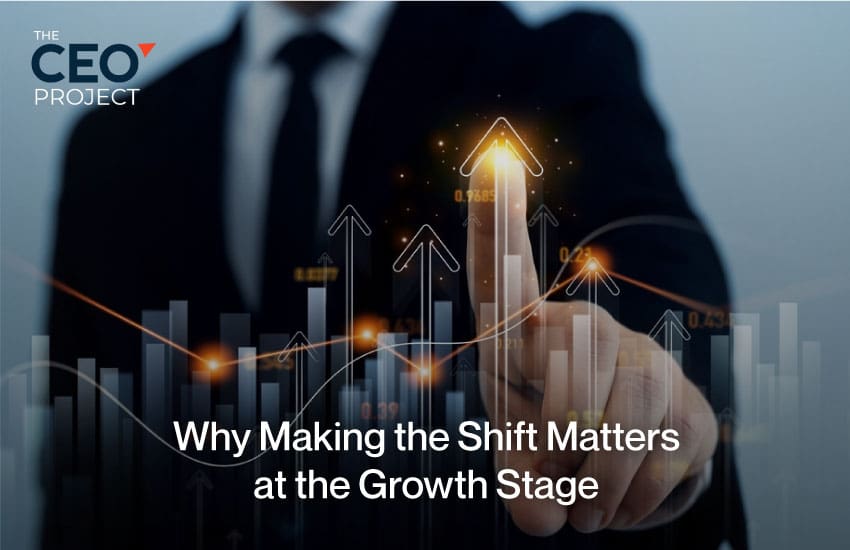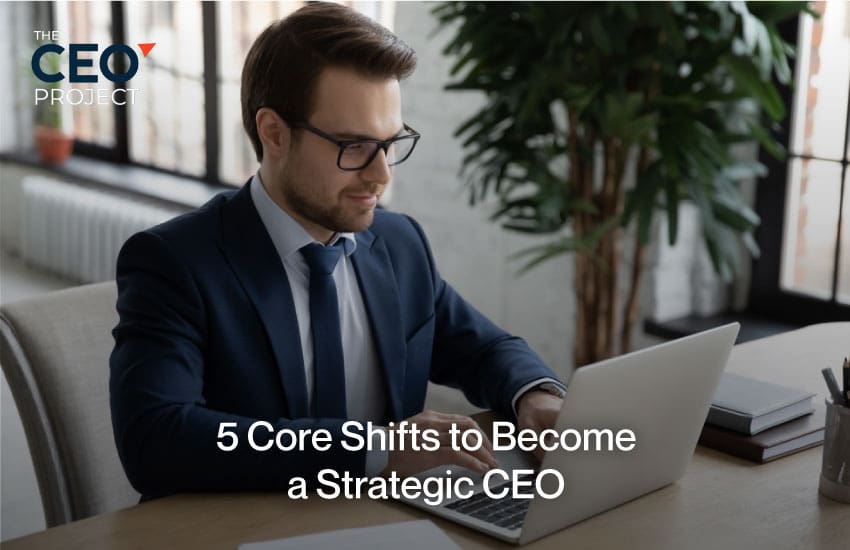Your life as a CEO can feel overwhelming when there’s a never-ending list of tasks that demand your attention. But as your business expands, doing multiple jobs at the same time can limit its potential. The move from operations management to strategic leadership isn’t just a challenge; it’s an imperative for longer-term success. According to a recent study, 40% of a company’s success is directly related to how well the CEO performs. These figures make it clear how important it is for CEOs to grow and adapt their roles as the business scales.
In this post, we here at The CEO Project are going to guide you through the process of transitioning from being an operational CEO to becoming a strategic visionary and why this shift is essential for the success and future of your company. Whether you are at a rapid growth stage or are trying to position your company for the next level of growth, it is the move from the day-to-day to the clear execution of a focused strategy that breaks you free of plateaus.
Whether you’re growing rapidly or simply want to be ready for another high-growth cycle, the key to getting unstuck is shifting your focus from day-to-day operations to making a clear, compelling plan to shape your business’s future.
Let’s explore and understand how to make this transformation and discuss the central shifts that will enable you to take the lead with purpose, clarity, and long-term vision.

The CEO’s Evolution is the Company’s Future
At the early stage of a company, the CEO plays multiple roles—from managing operations to running sales, customer service, and sometimes the business’s finances. Although this sounds plausible in your startup phase, it becomes unsustainable as the company grows. In order to move and scale forward, CEOs must move beyond operating and start thinking about the future of the organization.
As a well-known leadership coach, Marshall Goldsmith says,
“What got you here won’t get you there.”
This describes the reality that, as a CEO, what has worked for you in the past and how you are used to operating might not be what the company needs right now. The question to ask yourself: Are you leading your company, or just running it?
How you grow determines the future of your business. When you choose to look at the bigger picture, you are preparing your organization to succeed in the long term through growth, innovation, and sustainable success.

Difference Between an Operational CEO and a Strategic Visionary
Key differences in the responsibilities and roles of an Operational CEO and the Strategic Visionary CEO are given below:
| Operational CEO | Strategic Visionary CEO |
| Manages tasks | Designs direction |
| Solves urgent problems | Anticipates future obstacles |
| Controls decisions | Delegates with clarity |
| Works in the business | Works on the business |
| Optimizes efficiency | Prioritizes growth and impact |
The strategic visionary CEO seeks to find opportunities for the business to thrive while managing the complexity. Instead, an operating CEO tends to be more reactive, addressing day-to-day concerns and making decisions that sometimes prove necessary just to keep the company afloat.
So you’re ready to step up your leadership? Time management is the skill that is most important to any CEO. If you would like to find out how high-performing CEOs use their time wisely and keep their focus on what really matters, then you must check out our recent blog, “How High-Performing CEOs Manage Their Time Effectively.”

5 Signs You’re Still Operating & Not Leading Strategically
How do you recognize when you’re struggling to make that shift from being an operational CEO? Here’s a quick checklist:
- You’re the bottleneck for most decisions: You’re the one everyone depends upon for the calls, and that’s holding back everything.
- Your calendar is filled with tactical meetings: You address just immediate concerns instead of spending time on long-term objectives.
- You don’t spend time thinking about a 3–5 year direction: Your vision is short-term and reactionary, not future-focused.
- You feel like a firefighter more than a strategist: Instead of leading strategic initiatives, your role feels more like putting out fires one after another.
- You’re the most informed person in the room on everything: You’re on the ground doing the nitty-gritty, having not much time for strategic impact.
These are signs that you’re still stuck in day-to-day operations. If you want your business to succeed, you must reinvent your mindset and role to become a visionary leader.

Why Making the Shift Matters at the Growth Stage
Once companies scale, they tend to plateau if the CEO doesn’t shift from being the solution-finder to their role as a strategic leader. When the CEO is over-functioning and doing too much themselves, teams simply cannot execute or perform at the highest levels. Growth necessitates creating leaders at every level of the organization, not just working harder as the CEO.
A valuable insight from The CEO Project is that
“The CEO’s job is to build a machine that builds the business.”
CEOs need to focus on building systems, culture, and leadership to support growth rather than simply completing day-to-day tasks. This translation to strategic leadership makes the business less dependent on the CEO’s day-to-day involvement.

5 Core Shifts to Become a Strategic CEO
Transitioning from operating to leading strategically is one of the most critical shifts a CEO must make to scale their business and reach new levels of success. Recent research has shown that CEOs who spend more time on strategic thinking and strategic formulation achieve 20% faster revenue growth than their counterparts, who instead focus on tactics execution.
The capacity to grow and move into a position where they can think more strategically is not only good for company growth in the long term, but also personally suitable for the CEO, who is becoming a better leader. Below, we take a look at five key changes that every CEO needs to make in order to be more strategic in their leadership.
- Shift 1: From Problem Solver → Question Asker
- Shift 2: From Time-Filled Calendar → Time-Blocked Thinking
- Shift 3: From Task Ownership → Outcome Delegation
- Shift 4: From Information Hoarder → Context Giver
- Shift 5: From Busy Operator → Vision Architect
Shift 1: From Problem Solver → Question Asker
Rather than continuing to leap into action mode, the strategic CEO concentrates on asking questions to really figure out cause and effect and see what the future holds. This change in approach will lead CEOs to stop “fixing” problems in near real-time and to begin building lasting solutions that prevent issues from coming back.
- Focus on long-term solutions: Ask yourself, “How do we make sure this doesn’t happen again?” as opposed to “How can we now correct this?”
- Encourage team involvement: Your team should feel able to identify issues and solve problems together.
- Think strategically: Ask strategic-formulating questions that will nudge your thinking, like “What opportunities could come out of this problem?” or “How does this factor into our strategic goals?”
- Use the five whys method: Try to find why something’s happening by asking “why” over and over, until you get to the root cause of the issue.
By asking the right questions, CEOs can ensure that issues are addressed in a manner that is consistent with the company’s strategic direction.
Shift 2: From Time-Filled Calendar → Time-Blocked Thinking
A CEO’s days are typically loaded with meetings, emails, and administrative work. But if you aspire to be a strategic leader, it’s essential to set aside time for deep thinking and reflection about the long-term goals of your company. By setting aside time for strategy, you can concentrate on high-impact choices and actively point the business in one direction.
- Schedule strategic thinking sessions: Reserve time in your schedule to concentrate on high-level strategy and nothing else.
- Reduce tactical meetings: Try to confine your involvement in meetings that are not essential to decisions that require your input.
- Prioritize deep work: Take time to research market trends, analyze the company’s performance, and identify new potential opportunities.
- Review long-term goals: Revisit your 3-5 year vision regularly to make sure the business is going in the right direction.
Time-blocking for strategy is critical to make sure you stay aligned with the vision of the company and have the mental capacity to make strategic decisions.
Shift 3: From Task Ownership → Outcome Delegation
As a strategic CEO, it is critical to stop micromanaging and instead delegate with clear outcomes. When you delegate properly, your team becomes empowered to carry out the work on their own, and you can concentrate on high-level strategic direction.
- Delegate with clear outcomes: Instead of directly assigning tasks, discuss what the result should look like and let your team members figure out how to achieve it.
- Trust your team: Give your leaders the confidence to make decisions without seeking input and approval all the time.
- Set expectations: Communicate clearly the results you want to achieve and provide your team with the resources and support they need to be successful.
- Evaluate results, not processes: Focus on what gets accomplished, not how it is performed, in order to foster innovation and problem-solving.
Delegating results allows you to spend more time focusing on strategy and reinforces the idea of ownership and accountability among your group.
Shift 4: From Information Hoarder → Context Giver
Many CEOs fall into the trap of needing to know every detail about the business. On the other hand, a strategic CEO will set the stage for their leadership team so that they can make informed decisions without having to consult the CEO on every decision. This transition results in faster decision-making and more empowered teams.
- Share the “why” behind decisions: Share not only the “what” of your strategic direction but also the “why” so that your team knows how to align with your decisions.
- Encourage independent thinking: Give the context needed, but take a step back and let your team make the decisions.
- Focus on key priorities: Instead of getting stuck in every micro detail, concentrate on the most significant aspects that help the company grow.
- Build trust: The more context you provide, the more trust you generate with your leadership team, and the more confidence you give them to act without your hand-holding.
By providing context and not holding onto every piece of information, you empower your leadership team to be nimbler and more effective.
Shift 5: From Busy Operator → Vision Architect
The last shift is transitioning from a busy operator to the architect of the company’s vision. That means you spend less time on the day-to-day and more time on strategically planning for the future. A visionary CEO who guides the company to new heights and unites the team toward a common purpose.
- Define a clear vision: Establish a clearly articulated vision for the future of your company that motivates your team and gets them excited.
- Communicate that vision: Keep communicating the vision to your team regularly, and use it to guide decision-making.
- Align the organization: All departments and teams should be aware of how their work adds value to the general vision.
- Create a culture of innovation: Empower your team to contribute to the vision by proposing new concepts and solutions.
As the architect of your company’s vision, your leadership will encourage your team and fuel long-term growth.

How to Restructure Your Role and Calendar
Reorganizing your position and schedule is essential for CEOs who want to transition from operator to a strategic leader. One of the most valuable resources for a CEO is time, and as a business grows, it’s even more important to spend your time on tasks that bring the company closer to its long-term objectives. By reanalyzing your time investment, you can make sure you’re focusing on your strategic vision and not getting stuck in tasks that other members of your organization can undertake.
Recent research reveals that 30% to 40% of a CEO’s time is spent on daily operational work. Still, as a business grows, CEOs must repurpose their focus to strategy in order to push the company forward.
According to a McKinsey study, firms that are proactive in treasuring strategic leadership lead to an average of 20% compounded annual growth compared to those sticking to routine operations. Reorganizing your calendar and responsibilities to carve out time for strategy is not just good for business; it leads to more balanced and effective leadership.
Here’s how to redefine your role and your calendar to move into strategic leadership:
- Review What’s on Your Plate
- Identify What Only You Can Do
- Categorize the Rest into Delegate, Automate, or Drop
1. Review What’s on Your Plate
The first step to reorganizing your role is to analyze your day job closely. Knowing where you’re spending your time means you can pinpoint where your involvement may not be needed and clear a path for strategic thinking. This type of evaluation will help you be more focused on your choices and actions.
- Track your daily tasks: Spend a week monitoring everything that you are doing. Review meetings, calls, emails, and tasks to pinpoint what’s consuming most of your time.
- Evaluate the importance: Determine whether these tasks are helping you build a business or if they’re simply maintaining the status quo.
- Consider delegation opportunities: Is there any work that can be done by your management staff or outsourced?
- Prioritize long-term growth: Determine which activities serve your company’s long-term vision and allocate time to them.
2. Identify What Only You Can Do
As CEO, there are some things that only you can do, and these generally fall into the categories of strategic decision-making, vision-setting, and culture-setting. Understanding these tasks will allow you to prioritize your time and ensure that you’re spending time on high-impact activities.
- Define your unique contribution: What decisions, actions, or insights can you deliver that nobody else is in a position to do? This could be defining the mission or hiring key people.
- Think beyond the daily grind: Focus on long-term projects that will fuel company growth, such as market expansion, new product development, or partnerships.
- Set boundaries: Protect your time for higher, strategic work and not get lost in day-to-day tasks.
- Lead through inspiration: Concentrate on what motivates and guides your team towards the company’s objective, not on the day-to-day operation.
3. Categorize the Rest into Delegate, Automate, or Drop
The majority of your daily tasks should be delegated, automated, or discarded. This will free you up to concentrate on high-level strategy and help ensure that your company is set up to keep moving forward without you needing to weigh in on every little task.
- Delegate: Let your team of leaders run with day-to-day responsibilities. Make sure they know what’s expected of them and what decisions they can make.
- Automate: Use technology to do repetitive work. This may include reporting tools, financial tools, or customer relationship management tools.
- Eliminate: Find out what is not helpful in scaling your company and strike it off your calendar. This may be hundreds of obsolete processes or projects that no longer align with the company’s strategic ambitions.
- Monitor performance: After you’ve delegated or automated tasks, be sure to monitor the successes and tweak as required to ensure optimum productivity.
Repositioning your role and calendar with these strategies will help you have the time necessary to do what really matters —drive long-term growth and position your company for future success. More efficient use of your time will also make you a more effective leader, preparing you to be a strategic visionary for your organization.
The transformation isn’t only necessary for growing your company but also for you to grow as a leader. Take some time today to assess how you can redirect your efforts to better support your company’s strategic goals.

Your Company Will Only Grow as Fast as You Evolve
The transition from an operational CEO to a visionary one is not merely an option; it is a crucial one that will define your company’s future. The higher a business grows, the more importance should be placed on strategic leadership—to drive growth, encourage innovation, and enable teams to work together to achieve common objectives.
When you stop getting involved in day-to-day organizational tasks and start leading from a clear vision, you will create a clear path to long-term success.
Your company’s growth depends on how you grow as a CEO. It all begins with how a CEO thinks and leads and what expectations are set for them. If you keep getting stuck doing the operational work, you will stall your company’s growth. Strategic thinking is the move.
Reflective Question: What is one operational task you can stop doing this week to make time for strategy? Begin by throwing off small tasks to focus on what delivers long-term value.
Peer groups such as The CEO Project are priceless for chief executives who are ready to change. In a high-performing CEO peer group, you’ll get the support and accountability you need to grow your leadership and your situation.
FAQs
How do you become a visionary CEO?
To become a visionary CEO, you need to stop thinking tactically and instead think strategically for the long term. This requires a vision of the market’s direction, an awareness of challenges, and a list of actionable points. You also need to promote innovation and enable your team to take responsibility for the outcome.
What is the roadmap to becoming a strategic CEO?
The roadmap calls for moving from being an operational CEO to a strategic visionary who leverages delegation, sets clear outcomes, and regularly recites the company’s vision and goals. Some of the main ones include making time for strategic thinking, creating leadership at all levels, and empowering your team.
Why is it important for CEOs to evolve?
As your business grows, being stuck in day-to-day operations could stunt its potential. Becoming a strategic CEO enables you to concentrate on growth, innovation, and sustainability. You need to go through that one to break through plateaus and attain long-term success.
What does it mean to be the CEO of the future?
The future CEO is no longer a mere overseer of day-to-day operations but also a strategic leader who encourages innovation, advocates long-term growth, and instills a culture of leadership that permeates the entire company.



